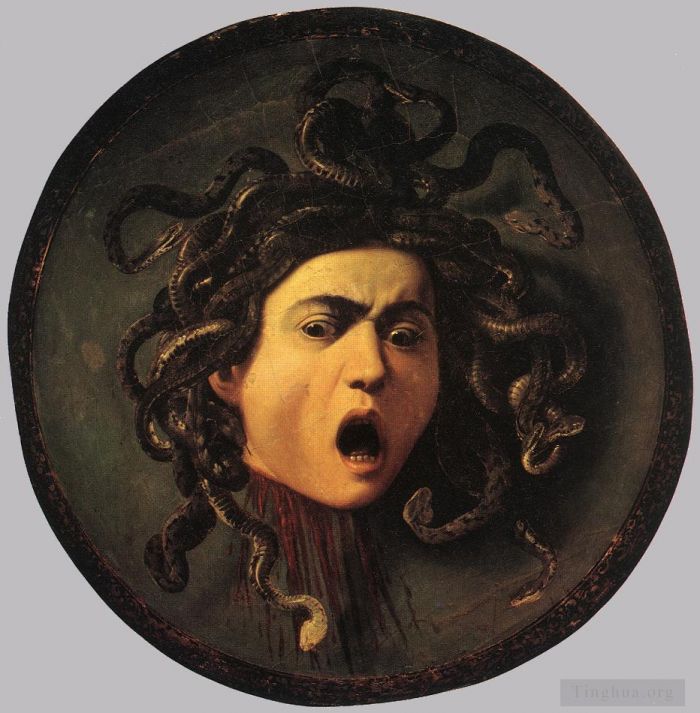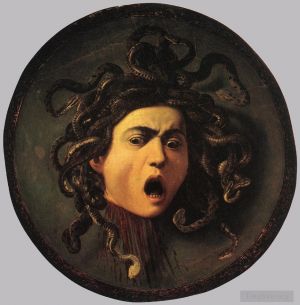Medusa
Caravaggio
- Price: Price on Request
- Art Type: Oil Painting
- Size:
- English Comments: 0
- International Comments: 0
- Creating Date:
- Introduction and Works of Caravaggio >>
Keywords:
Medusa
Work Overview
- Medusa
Italian: Testa di Medusa
Artist Caravaggio
Year 1597
Type Oil on canvas mounted on wood
Dimensions 60 cm × 55 cm (24 in × 22 in)
Location Uffizi, Florence
Caravaggio painted two versions of Medusa, the first in 1596 and the other presumably in 1597.
The first version is also known as Murtula, by the name of the poet who wrote about it, Gaspare Murtola (d. 1624): "Flee, for if your eyes are petrified in amazement, she will turn you to stone."[1] It measures 48 by 55 cm and is signed Michel A F (Latin: Michel Angelo Fecit), "Michel Angelo made [this]", Michelangelo being Caravaggio's first name. This work is privately owned.
The second version, shown here, is slightly bigger (60×55 cm) and is not signed; it is held in the Uffizi Gallery in Florence.
In order to appreciate Caravaggio’s painting of Medusa, it is important to know its background. A gorgon is a terrifying female creature in Greek mythology. Medusa was a gorgon with a mane of serpents for hair. She was so repulsive, that whoever looked at her, supposedly turned to stone. Perseus, the Greek hero, was given a shield by the goddess Athena, so that he could avoid looking at her, as he decapitated or beheaded her.
Medusa in Caravaggio’s painting is portrayed at the moment of self-recognition. Realizing that her head and body were no longer one, and that she was still conscious, Caravaggio depicts the horror in her eyes. Medusa is a wonderful example of Caravaggio’s focus on physiognomic, or facial expression in his paintings. Medusa shows an intense level of realism, and Caravaggio uses dark and light contrasts so effectively that Medusa looks three-dimensional.
Michelangelo Merisi da Caravaggio (1571-1610)
Caravaggio, from Milan, Italy, was a part of the Baroque art movement. He was commissioned to paint Medusa as a gift for the Grand Duke of Tuscany, to be placed in the Medici collection in Florence. Caravaggio was a pioneer in Italian Baroque style, which grew out of the Mannerist art movement. Italian Baroque was very similar to Italian Renaissance, yet the color palette was darker, and richer, and themes of religion were more popular.
Caravaggio was known for his naturalistic, and realistic paintings, termed Baroque realism. He used subjects who directly appealed to human emotions. His many light-to-dark contrasts made the paintings life-like, as if they were almost looking back. Medusa was a special commission for Caravaggio, because it enabled him to compete with Leonardo da Vinci, by submitting his painting to be viewed by the Medici family, as da Vinci did before him.
Medusa: The Second Version
The first version of this painting was named Murtula, after the poet who wrote about it, and was smaller in size. It was signed Michel A.F. (for Michel Angelo Fecit), and is privately owned. Medusa is an oil on canvas painting, mounted on a convex wooden shield. It is 60 x 55 cm. Caravaggio painted Medusa in 1597, and it is unsigned. It is displayed at Galleria degli Uffizi, in Florence, Italy.
In Greek myth, Perseus used the severed snake-haired head of the Gorgon Medusa as a shield with which to turn his enemies to stone. By the sixteenth century Medusa was said to symbolize the triumph of reason over the senses; and this may have been why Cardinal Del Monte commissioned Caravaggio to paint Medusa as the figure on a ceremonial shield presented in 1601 to Ferdinand I de' Medici, Grand Duke of Tuscany. The poet Marino claimed that it symbolized the Duke's courage in defeating his enemies.
As a feat of perspective, the picture is remarkable, for out of the apparently concave surface of the shield - in fact convex- the Gorgon's head seems to project into space, so that the blood round her neck appears to fall on the floor. In terms of its psychology, however, it is less successful. The boy who modelled the face (in preference to a girl) is more embarrassed than terrifying. For once Caravaggio cannot achieve an effect of horror; he was to find in the legends of the martyrs a more powerful stimulus to the dark side of his imagination than classical myth.
- Copyright Statement:
All the reproduction of any forms about this work unauthorized by Singing Palette including images, texts and so on will be deemed to be violating the Copyright Laws.
To cite this webpage, please link back here.
- >> English Comments
- >> Chinese Comments
- >> French Comments
- >> German Comments
- >>Report
- Saint Jerome in Meditation
- Still Life with Flowers and Fruit
- The Musicians
- St John the Baptist Youth with Ram
- Supper at Emmaus
- Madonna and Child with St Anne
- Flagellation
- The Sacrifice of Isaac
- Young Sick Bacchus
- Nativity with St Francis and St Lawrence
- Portrait of Alof de Wignacourt1
- St John the Baptist
- The Sacrifice of Isaac2
- The Conversion of St Paul
- David with the Head of Goliath
- The Crucifixion of Saint Peter
- St John the Baptist1
- Narcissus
- Medusa
- Beheading of Saint John the Baptist
- The Martyrdom of St Matthew
- Boy with a Basket of Fruit
- The Denial of St Peter
- Salome with the Head of the Baptist
- Portrait of Alof de Wignacourt2
- St John the Baptist2
- St Francis1
- Saint Jerome Writing (Saint Jerome in His Study or simply Saint Jerome)
- Adoration of the Shepherds
- St Francis2
- Sleeping Cupid
- Saint Jerome Writing
- Christ in the Garden
- Jupiter Neptune and Pluto
- St John the Baptist at the Well
- Portrait of Maffeo Barberini
- The Crucifixion of St Andrew
- David with the head of Goliath
- Portrait of a Courtesan
- The Crowning with Thorns2
- Burial of St Lucy
- St Matthew and the Angel
- Boy Peeling a Fruit
- Ecce Homo
- The Seven Acts of Mercy
- The Entombment
- St Francis in Ecstasy
- The Inspiration of Saint Matthew
- Lute Player
- Judith Beheading Holofernes
- St John the Baptist
- The Incredulity of Saint Thomas
- The Fortune Teller
- The Tooth Drawer
- St Catherine of Alexandria
- Basket of Fruit still life
- David with the Head of Goliath
- The Crowning with Thorns
- Bacchus
- The Calling of Saint Matthew
- Boy Bitten by a Lizard
- The Raising of Lazarus
- Salome with the Head of St John the Baptist
- Magdalene
- The Conversion on the Way to Damascus
- Rest on Flight to Egypt
- The Fortune Teller
- The Lute Player
- The Annunciation
- Taking of Christ
- Amor Victorious
- Madonna di Loreto
- Christ at the Column
- The Death of the Virgin
- The Martyrdom of St Ursula
- Madonna del Rosario
- The Cardsharps
- Supper at Emmaus
- Martha and Mary Magdalene









 Singing Palette
Singing Palette